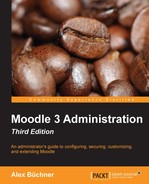As an administrator, you will be performing most tasks from the Site administration section in the ADMINISTRATION block, which you will see once you log in to Moodle. We will cover all the aspects of the menus and submenus throughout the remainder of the book:

The items displayed in the preceding screenshot will change, depending upon where in Moodle it is shown. For example, inside a course, an additional Course administration section will be displayed. As administrator, you will always see the Site administration section; other users with lesser rights will only see the menu items they have access to.
You can dock the Settings block (like any other block) to the left to save space by clicking on the Dock administration block icon in the top-right corner of the block. Once you hover over the docked block, it will pop out.
Moodle uses the so-called breadcrumb trail interface for its navigation. Once you select a menu or submenu item, Moodle displays the respective crumbs in your navigation bar. These crumbs can be used to jump back to any previous menus. In the following menu, the trail consists of five crumbs:

The first crumb is always the name of the site and represents your Moodle front page (here, called Home). That is, if you ever get lost, click on the first crumb, and you will be back in familiar territory. Throughout the book, we will be referring to the location of menu items in the Site administration section via a consistent notation, for instance, go to Plugins | Repositories | File system for the trail shown in the preceding screenshot.
In Appearance | Navigation, it is possible to change the way the navigation bar behaves. More on this in Chapter 7, Moodle Look and Feel.
To simplify the identification of any setting in the administration section, a search facility is provided, which is located below the hierarchical Site administration menu.
When searching for any term, Moodle displays the results in an expanded form that allows you to change settings immediately. For example, when searching for calendar, numerous sections appear as a result, which can be changed in each section straightaway, rather than navigating to each separate section to make changes.
The search facility is also highly beneficial when upgrading from older versions of Moodle where configuration settings have been re-organized and their location is difficult to trace.
Bookmarks are shown in the ADMIN BOOKMARKS block, which has to be added by clicking on Turn editing on and selecting the block from the Add a block pull-down list. They allow bookmarking any admin menu for easy access to the pages that you require regularly. Select Bookmark this page to add a bookmark and Unbookmark this page to delete it. Moodle automatically displays the latter option, when you are on the bookmarked page:

In the preceding screenshot, two pages have already been bookmarked (Browse list of users and File system) and the mentioned link is provided to add more bookmarks.
The entire Moodle documentation is online at https://docs.moodle.org/en/Main_page. If you wish to provide your own documentation, modify the Moodle Docs document root setting in Appearance | Moodle Docs. On this screen, you can also select Language for docs that will be used in links for the documentation pages and enable the Open in new window option. A link at the bottom of each page provides a reference to the relevant page in Moodle Docs. In addition to the actual online documentation, some features provide inline help, which is indicated by a question mark symbol. When it is clicked, a help window will appear, providing assistance relevant to the respective topic.

For instance, when clicking on the Moodle Docs for this page link in the Upload users section, the following article will be opened:

For each version of Moodle, separate Moodle Docs are published. The preceding screenshot is from version 3.0.
The Moodle community is growing continuously and, at the time of writing, had well over 1 million registered users (yes, that's 1 million!), of which, over 5% are active. If you cannot find a solution to any of your Moodle problems in Moodle Docs, use the Search moodle.org functionality at the top of the screen at moodle.org. In order of priority, the search brings forth the already mentioned Moodle Docs, the most active user forums, and the
Moodle Tracker, which keeps track of all the issues and feature requests (https://tracker.moodle.org/secure/Dashboard.jspa). A search in the Moodle forums can often result in a large number of links. To narrow down the search space, use Advanced search in the Search forums block. If you still cannot find the solution to your problem, which is relatively rare, post a question on the relevant forum, and somebody is likely to assist you further.
